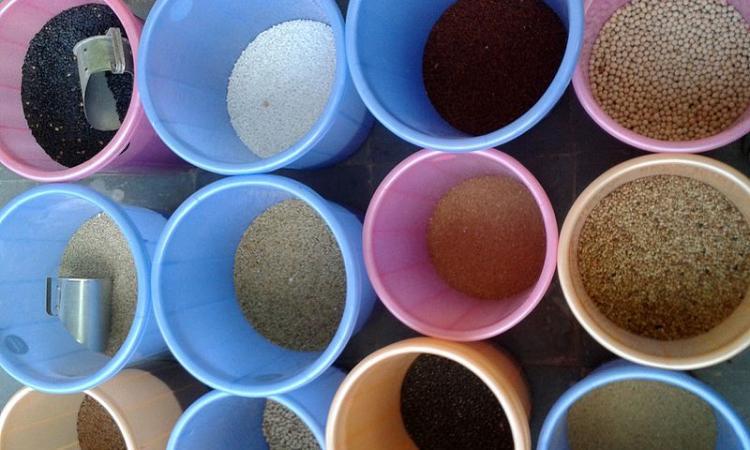
Agricultural stagnation and inefficient irrigation systems
Agriculture continues to be an important sector for the Indian economy and for food security with more than half of the workforce being employed in agricultural activities. Greater use of improved crop varieties, irrigation and fertilisers have contributed to major improvements in crop yields in India.
While the pressure on agriculture continues to grow with the increase in population, the Economic Survey 2019-20 shows that the average annual growth rate in real terms in agriculture as well as its allied sectors has remained static over the last six years, impacting farmers’ incomes.
This stagnation has to do with inefficient irrigation systems and degradation of soils due to improper use of chemical fertilisers. It is thus important to focus on sustainable agricultural practices to support small and marginal farmers. These include dynamic cropping patterns, judicious use of chemical fertilisers, efficient irrigation systems and a shift in focus in agriculture from ‘land productivity’ to ‘irrigation water productivity’.
And the situation is serious indeed! This paper 'Trading water: virtual water flows through interstate cereal trade in India' published in Environmental Research Letters informs that groundwater resources are rapidly declining in the major food producing states of Punjab, Haryana and Uttar Pradesh in the north, and Tamil Nadu and Karnataka in the south.
Recent shifts in agricultural practices to produce more food in the dry season to cope with unreliable rainfall in the wet season have increased dependency on groundwater and surface water resources for irrigation.
Cereals dominate agricultural production in India
Agricultural production in India continues to be dominated by cereals that comprise 45 percent of all agricultural produce and contribute 47 percent of the total daily dietary energy intake.
India is self-sufficient in cereals and imports only 0.01 percent of the national cereal supply from other countries, and is a major exporter of rice and wheat globally. Cereals are traded in India in between states as well as internationally.
However, very less is known about the pressure exerted on water resources in terms of total amount of water (virtual water) required to grow cereals in India and trade them within the country as well as internationally.
What is virtual water
Virtual water is the amount of water that is needed/embedded in food or other products in their total production process. Trade in virtual water allows water scarce countries to import high water consuming products from water abundant countries and export low water consuming products thus aiding in saving water and making it available for other purposes.
All water, blue (irrigation), green (rainwater), grey (contaminated ) utilised by the food and agricultural system is virtual. Once extracted, all water becomes invisible to all the food supply chain stakeholders and the end level consumers. Whether the food and/or agricultural commodities are traded within the country or internationally does not change the fact that the water was extracted and embedded.
Virtual water flows and cereal trade in India
The paper discusses the findings of a study that quantifies the interstate and international trade of cereals in India, and the associated trade of embedded or virtual water to understand the dependency of the Indian food system on water resources. The study looks at interstate cereal trade flows through both road and rail transport, and includes distribution through the Public Distribution system (PDS) and international trade.
The study uses state-level data on production, foreign imports and exports, PDS procurement, stocks, nonfood uses and amounts available for food consumption for five major cereals consumed in India namely wheat, rice, maize, millet and sorghum.
The study finds that:
As high as 40 percent of the cereal food supply was traded for food consumption between states in 2011–12 with a total virtual water flow of 153.4 km3with 54.0 km3 as embedded blue water, and 99.4 km3 as embedded green water.
States with over-exploited groundwater produced 41 percent of the interstate exported cereals, and a further 21 percent was produced and exported from states with semi-critical or critical groundwater reserves.
As high as thirty one of the thirty five Indian states with 76 percent of the population rely at least in part on cereals produced in states with over-exploited groundwater. While Indian interstate trade encourages the production of crops that use less rainwater and surface water in their production, it leads to high use of groundwater per year.
Rice and wheat are the dominant crops that are traded from the groundwater stressed regions of North India, thus increasing the vulnerability of India’s food systems to changing water availability.
The study argues for the need to:
- Introduce changes in production and interstate trade patterns, in irrigation methods and in the type of cereals consumed to improve the resilience of India’s food system.
- Increase the diversity of crop production to reduce risk and enhance the diversity of food consumption. The Indian Central Goods and Service Tax that came into effect in 2017 aims at streamlining the trade of goods and services between states by reducing processing and travel time and can offers an opportunity to improve the sustainability of the Indian food system through diversification of food supply for consumers.
- Plan interventions to reduce groundwater use and limit food production in overexploited areas to maintain water security.
The paper can be accessed here